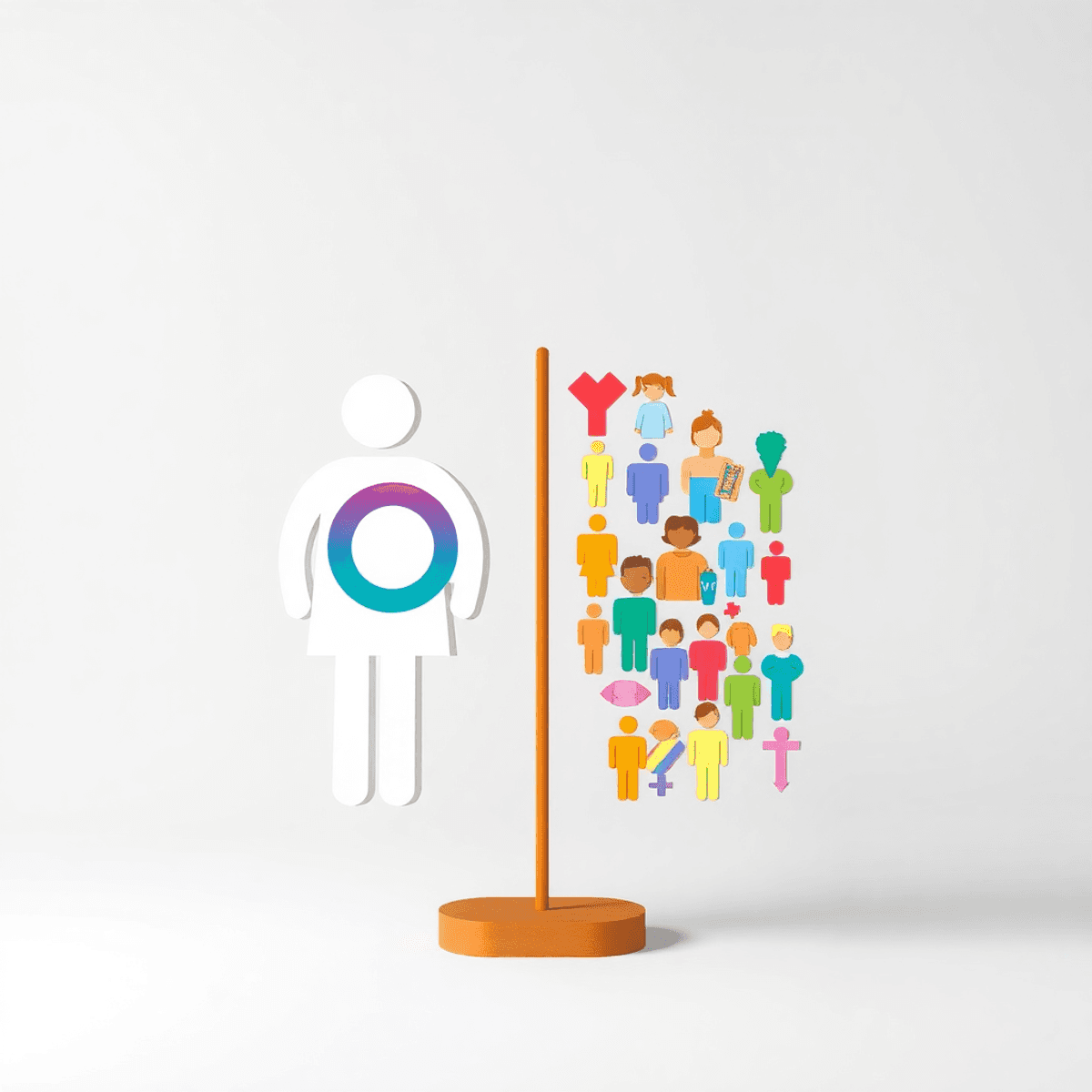
What is the difference between sex and gender?
Sex and gender are two terms that are often used interchangeably, but they actually have different meanings. Many people think these concepts are the same, which can lead to misunderstandings when talking about identity, biology, and social roles.
Understanding the difference between sex and gender is important for several reasons:
- Healthcare decisions – Medical professionals need to understand this distinction in order to provide appropriate care
- Personal identity – It helps individuals explore and express their true selves
- Social interactions – Having a clear understanding promotes respectful communication
- Scientific research – Accurately distinguishing between sex and gender leads to better study designs and results
- Legal frameworks – Laws and policies can affect different groups based on their sex or gender
The distinction between sex and gender affects everything from our everyday interactions to major decisions in our lives. For example, when it comes to online dating or marriage, understanding these differences can greatly impact personal choices. Websites like BridesUniverse offer resources for those looking for mail order brides, a decision that may be influenced by both sex and gender perceptions.
Additionally, exploring personal identity can also extend into areas such as adult entertainment. Platforms like LuvRatings provide alternatives to mainstream sites, further emphasizing the connection between sex, gender, and personal choice.
In this article, we will take a closer look at these concepts in order to gain a better understanding of human identity and experience.
Understanding Biological Sex
Biological sex refers to the physical attributes that distinguish males from females. These attributes include:
- Chromosomes: Females have XX chromosomes, while males have XY chromosomes.
- Reproductive organs: Ovaries are present in females, and testes are present in males.
- External genitalia: Males have a penis and scrotum, whereas females have a vulva.
- Secondary sexual characteristics: Breasts develop in females, facial hair grows in males, and voice depth varies between the sexes.
- Hormone levels: Testosterone is primarily found in males, while estrogen and progesterone are predominant in females.
How Biological Sex is Determined
Medical professionals determine a person’s biological sex at birth by examining their external genitalia. This classification becomes part of the individual’s legal identity and medical records, which can influence healthcare decisions throughout their life.
Limitations of Binary Classification
The traditional binary classification of biological sex (male or female) does not consider the natural variations that exist in human biology. Intersex individuals are those who possess a combination of male and female physical characteristics. These variations can occur in several ways:
- Chromosomal patterns that deviate from the typical XX or XY configurations
- Reproductive organs that are mixed or ambiguous
- Hormone production levels that do not align with conventional male or female patterns
- External genitalia that cannot be clearly categorized as male or female
Research suggests that around 1.7% of people are born with intersex traits, making this variation as common as having red hair. Our understanding of biological sex is continually evolving, revealing its intricacies beyond simple male-female categories.
Understanding Gender Identity
Gender identity represents your innermost understanding and experience of who you are as a person. This deeply personal sense of being male, female, both, neither, or somewhere in between exists independently from your biological characteristics.
Your gender identity might align perfectly with your assigned sex at birth – making you cisgender – or it might differ, as experienced by transgender individuals. This internal knowledge of your gender can emerge at different ages and may evolve throughout your life.
The Role of Society in Shaping Gender
Society plays a significant role in shaping how gender is expressed and perceived:
- Gender Expression: The way you present your gender through clothing, hairstyles, mannerisms, and behaviors
- Social Roles: The expectations placed on individuals based on their perceived gender
- Cultural Norms: The unwritten rules about “appropriate” behavior for different genders
These societal expectations create gender norms that influence various aspects of life:
- Career choices and opportunities
- Family responsibilities
- Social interactions and relationships
- Personal appearance standards
- Behavioral expectations
The Variability of Gender Norms
Gender norms vary significantly across cultures and time periods, highlighting their socially constructed nature. What’s considered “masculine” or “feminine” in one society might be viewed differently in another, demonstrating that these roles aren’t biologically determined but rather shaped by cultural context and social expectations.
Personal Relationship with Gender
The relationship between your internal gender identity and external gender expression remains deeply personal. Some people choose to express their gender in ways that challenge traditional norms, while others feel comfortable conforming to societal expectations.
Exploring Relationships Beyond Traditional Boundaries
In this evolving landscape of gender identity and expression, online platforms such as mail order bride sites have emerged as avenues for exploring relationships beyond traditional boundaries. These sites offer unique opportunities to connect with individuals from diverse cultural backgrounds, each with their own understanding and expression of gender.
Moreover, for those looking to explore their sexuality further, there are alternative platforms like Chaturbate which provide live cam and VR shows catering to various sexual preferences. These platforms can serve as a means to embrace one’s sexual identity in a safe and consensual environment.
Understanding the Range of Gender Identities
Gender identity is not just limited to male and female. It exists on a wide spectrum, with many different ways in which people experience and express their gender.
Common Gender Identities
Here are some common gender identities that fall within this spectrum:
- Nonbinary: People who don’t identify exclusively as male or female. They might feel like a mix of genders, or like they exist outside the conventional gender categories
- Genderqueer: Individuals who reject traditional gender distinctions and embrace fluid gender expression
- Genderfluid: Those whose gender identity shifts or changes over time
- Agender: People who don’t identify with any gender
- Transgender: Individuals whose gender identity differs from their sex assigned at birth
Your gender identity can be:
- Aligned with traditional categories (male or female)
- Somewhere between these categories (e.g., bigender)
- Completely outside these boundaries (e.g., agender)
Think of gender as a vast color palette rather than just black and white – there are countless shades and combinations that reflect the unique ways people experience their gender.
The Importance of Recognizing the Gender Spectrum
Recognizing this spectrum allows for:
- Authentic self-expression
- Validation of diverse gender experiences
Many cultures throughout history have recognized multiple gender identities, showing that the gender spectrum isn’t a new concept but rather a return to a more nuanced understanding of human identity.
For a deeper understanding of the various types of gender identities, it’s essential to explore beyond the conventional definitions and embrace the diversity that exists within this spectrum.
Key Differences Between Sex and Gender
Biological sex is a scientific classification based on physical characteristics present at birth, such as:
- Chromosomal makeup (XX, XY)
- Reproductive organs
- Hormone levels
- Secondary sexual characteristics
On the other hand, gender identity is a deeply personal understanding of oneself that can change and develop over time. Unlike the measurable traits of biological sex, gender is expressed through:
- Self-perception
- Expression of identity
- Social roles
- Cultural context
It’s important to note that your assigned sex at birth does not determine your gender identity. For example, a person born with female biological characteristics may identify as male, or someone with male biology may identify as non-binary. This distinction emphasizes that biological sex is an objective medical category, whereas gender is shaped by your personal experiences and inner sense of self.
The medical community acknowledges this separation between physical traits and personal identity. Healthcare providers now recognize the difference between sex-specific health needs (such as prostate or ovarian care) and gender-affirming care that supports an individual’s authentic identity.
Why Recognizing Distinctions Matters in Society
Understanding the difference between sex and gender has profound implications for scientific research and healthcare delivery. Medical studies that fail to account for both biological sex characteristics and gender identity can miss crucial factors affecting patient outcomes.
Research shows that:
- Trans women taking hormone therapy may require different cancer screening protocols than cisgender women
- Mental health treatments benefit from considering both biological factors and gender-related social stressors
- Drug effectiveness can vary based on both hormonal profiles and gender-specific behaviors, as highlighted in this study
Beyond healthcare, recognizing these distinctions creates safer spaces in:
- Educational environments
- Workplaces
- Public facilities
- Sports programs
- Legal systems
The social impact of acknowledging gender diversity extends to reducing discrimination and improving mental health outcomes. Studies indicate that individuals whose gender identity is respected show:
- Lower rates of anxiety and depression
- Increased workplace productivity
- Better academic performance
- Stronger social connections
Organizations implementing gender-inclusive policies report improved employee satisfaction and reduced workplace conflicts. These benefits ripple through society, creating communities where people feel valued for who they are rather than confined by traditional expectations based solely on biological characteristics.
Common Misconceptions About Sex and Gender Debunked
Let’s tackle some persistent myths that create confusion about sex and gender:
Myth #1: “Everyone is either male or female”
This binary thinking overlooks biological diversity. Intersex individuals possess combinations of chromosomes and physical characteristics that don’t fit typical male/female categories. Similarly, gender expression exists on a spectrum, with many people identifying outside traditional male/female classifications.
Myth #2: “Gender identity is a choice”
Gender identity emerges from a deep internal sense of self, not personal preference. Research shows that gender identity develops early in life and remains consistent for most people, though some may take time to discover and express their authentic selves.
Myth #3: “Sexual orientation determines gender”
A person’s attraction to others bears no connection to their gender identity. Gay men are men, lesbian women are women, and bisexual people can identify across the gender spectrum. Each aspect of identity—sex, gender, and orientation—exists independently.
Myth #4: “Physical appearance defines gender”
Many people express their gender in ways that don’t match societal expectations. A woman might prefer short hair and suits, while a man might enjoy wearing makeup. These choices reflect personal expression, not gender identity.
Myth #5: “Sex and gender mean the same thing”
Sex refers to biological characteristics, while gender encompasses social roles, personal identity, and cultural expressions. A person’s gender identity may align with or differ from their biological sex, highlighting these concepts’ distinct nature.
The Role Language Plays in Shaping Our Understanding
Language is a powerful tool that reflects and shapes society’s understanding of sex and gender identities. As our recognition of gender diversity grows, so does the evolution of language, with new terms being introduced to describe various gender experiences and expressions.
Pronouns in Modern Communication
- She/her, he/him, they/them represent common pronoun choices
- Neopronouns like ze/zir or xe/xem provide additional options for gender expression
- Asking for and respecting pronouns demonstrates basic human dignity
- The use of gender-neutral language and pronouns is becoming more prevalent, allowing for a broader representation of gender identities
Creating Inclusive Spaces Through Language
- Replace “ladies and gentlemen” with “everyone” or “folks”
- Use “partner” or “spouse” instead of gender-specific terms
- Adopt gender-neutral job titles: “firefighter” vs “fireman”
Impact of Language Choices
- Validates diverse gender identities
- Reduces assumptions about gender based on appearance
- Creates safer environments for gender expression
- Builds trust and respect in communities
Language continues to adapt as our understanding of gender identity expands. Organizations now implement inclusive language guidelines, recognizing that words shape perceptions and experiences. Using appropriate pronouns and gender-inclusive language helps create spaces where all individuals feel seen and respected.
The medical and academic communities have also adapted their terminology, moving away from binary language to acknowledge the full spectrum of human identity. This shift reflects a deeper understanding that language carries power – power to include, validate, and recognize the lived experiences of people across the gender spectrum.
Conclusion
Sex and gender are two different but connected parts of who we are as humans. Biological sex includes our physical traits and genes, while gender is a personal experience influenced by society, culture, and individual factors. Understanding this challenges traditional views and helps us recognize various identities.
The connection between sex and gender shows the beautiful complexity of being human. By accepting both biological facts and personal identities, we make room for genuine self-expression and promote a more inclusive society. This understanding empowers people to live true to themselves and improves scientific knowledge and medical care for everyone, regardless of their gender identity.
Your understanding of these differences helps create a world where every person’s identity is respected, accepted, and celebrated.
FAQs (Frequently Asked Questions)
Sex refers to the biological classification based on physical attributes such as chromosomes and reproductive anatomy, typically assigned at birth. Gender, on the other hand, is a deeply felt personal and social identity that encompasses one’s sense of self and societal roles, which may or may not align with their biological sex.
How is biological sex determined and what are intersex individuals?
Biological sex is generally determined by physical characteristics like chromosomes (XX or XY) and reproductive organs. However, some individuals are intersex, meaning they possess a combination of male and female biological traits that do not fit typical definitions of male or female bodies.
What does gender identity mean and how does society influence it?
Gender identity is an individual’s deeply felt inner sense of their gender, which may differ from the sex assigned at birth. Society often imposes specific roles and expectations based on perceived gender, creating norms that influence how individuals express their gender identity.
Can you explain the spectrum of gender identities beyond male and female?
Gender exists on a spectrum rather than just the binary categories of male or female. This includes diverse identities such as nonbinary, genderqueer, and transgender individuals who experience and express their gender in ways that transcend traditional definitions.
Why is it important to recognize the differences between sex and gender in society?
Recognizing these differences leads to more accurate health research and personalized medical treatments for diverse populations. It also fosters inclusivity by respecting people’s self-identified genders, thereby reducing discrimination linked to rigid binary concepts.
How does language impact our understanding of sex and gender?
Language evolves alongside societal progress in recognizing diverse identities. Using appropriate pronouns and inclusive language validates individuals’ experiences and challenges binary notions, promoting respect and understanding across different gender identities.


